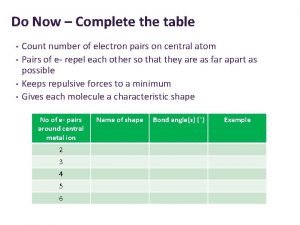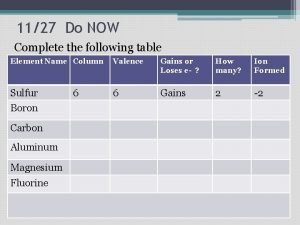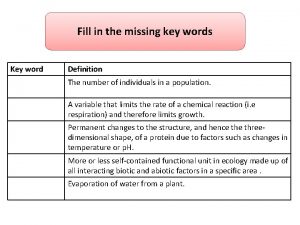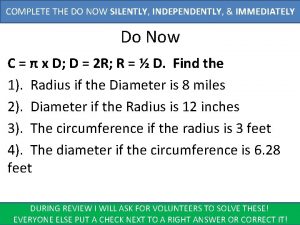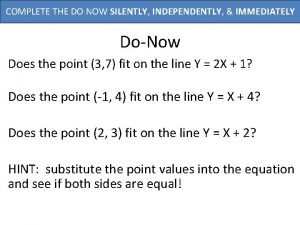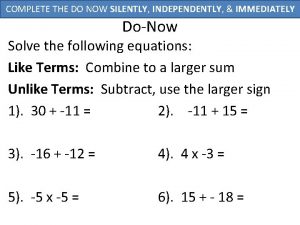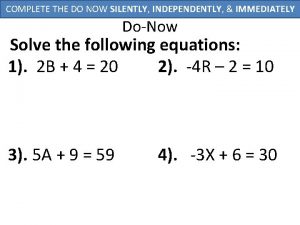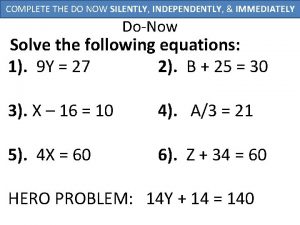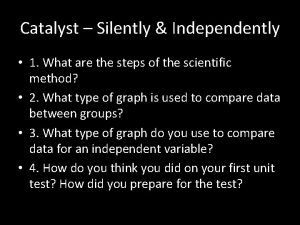Complete Do Now Silently Independently 1 Follow the




























- Slides: 28

Complete Do Now Silently & Independently 1. Follow the entrance procedure. 2. Have your homework in the top right corner to be check 3. Begin working on your Do Now Silently

DO NOW- Silently & Independently • 1. What are three principles of cell theory? • 2. What did you find out with your research? • **have homework out on your desk to be checked**

Objectives/Why does this matter? • EQ: are there different types of cells? • Objective: We will be able to use a Venn Diagram in order identify the key organelles and in eukaryotes and prokaryotes.

Agenda • • Do Now Updates INM: Eukaryotic vs. Prokaryotic Practice: Venn Diagram

Updates • Mid unit exam 1 covering cell theory, prokaryotes, and eukaryotes • Binder set up will occur next time because we still have people without binders.

What are some differences you see between these two cells?

Types of Cells - Prokaryotes - Eukaryotes

What are organelles? w A specialized part of a cell with a specific function w Mini “organs” of a cell.

All Cells - Are enclosed by a cell membrane. - Are filled with cytoplasm. - Have ribosomes - Have DNA (genetic material) cell membrane cytoplasm Bacterium (colored SEM; magnification 8800 x)

Common features of all cells 1. Cell Membrane – Outer layer that controls what enters & exits the cell

Common features of all cells 2. Cytoplasm – Jelly like material which cell organelles float in

Common features of all cells 3. DNA- genetic material

Common features of all cells 4. Ribosomes – site of protein synthesis

Fill in the middle part of the diagram with your partner. 1 minute silently and independently (must have at least 4 traits listed) Prokaryotes Eukaryotes

Prokaryotes Eukaryotes • Cell Membrane • Cytoplasm • DNA • Ribosomes

Nucleus a. DEFINITION: – – Control center of the cell the “brain” b. FUNCTION: -Stores all DNA Nucleus

Eukaryotes – Eukaryotic cells • Have a nucleus • Have organelles • Are larger in size • More complex structure • Multicellular nucleus organelles cell membrane cytoplasm

Prokaryotes – Prokaryotic cells • No nucleus • No organelles • Smaller in size • Simple structure • Unicellular nucleus organelles cell membrane cytoplasm

One way to remember the difference • Eukaryote – Eukaryote has true nucleus • Prokaryote – Prokaryote has no nucleus • EU has TRUE • PRO has NO

Fill in the left and right parts of the diagram with your partner using a volume 1 voice. (must have at least 5 traits listed for each) Prokaryotes Eukaryotes

Prokaryotes Eukaryotes • No Nucleus • Cell • Nucleus present • No organelles Membrane • Has organelles • Smaller in size • Cytoplasm • Bigger in size • Simple • DNA • Unicellular • Ribosomes • More complex • Multicellular organisms

Homework • Complete your Venn Diagram from class (if not completed) • Eukaryotic vs. Prokaryotic Sheet • Study for you test

EOC Practice Question • The diagram shows a drawing of a cell. Which cellular component identifies the cell shown as a eukaryotic cell? EXPLAIN your answer. a. Nucleus b. Ribosome c. Cytoplasm d. Cell membrane

EOC Practice Question • A student is assigned to determine whether a particular microbe is eukaryotic or prokaryotic. Which procedure is best suited to completing this assignment? – Measuring the amount of oxygen released using a sensor – Examining the DNA sequence of the microbes – Measuring the microbes using a micrometer – Examining the microbes under a microscope

EXIT TICKET 1. Make SURE to put your name!!! 2. Silently & independently

Which organelles can we identify on this cell?

Extra Questions to Consider • 1. Which characteristics do all prokaryotic and eukaryotic cells have in common? • A. cell wall B. nucleus C. cell membrane D. organelles • 2. Which characteristic is NOT common to both prokaryotic and eukaryotic cells? • A. cytoplasm B. reproduction C. nucleus D. cell membrane • 3. In general eukaryotic cells are… • A. smaller than prokaryotic cells B. larger than prokaryotic cells • C. about the same size D. visible to the unaided eye

Questions to Consider • • 4. What is the jelly-like substance in all cells? A. cell wall B. nucleus C. cytoplasm D. DNA 5. Which organelle is found in both cell types? A. nucleus B. cell wall C. ribosomes D. RNA
 The wind howled as if it were an angry wolf
The wind howled as if it were an angry wolf Silently adverb sentence
Silently adverb sentence I will follow you wherever you will go
I will follow you wherever you will go In your notebook answer the following questions
In your notebook answer the following questions Verb 3 shorten
Verb 3 shorten Circuit switching types
Circuit switching types Each packet is treated independently
Each packet is treated independently Diversity the art of thinking independently together
Diversity the art of thinking independently together Now i see it now you don't
Now i see it now you don't Bond angles
Bond angles World is now complete
World is now complete Now complete the following table
Now complete the following table Rewrite the sentences again
Rewrite the sentences again Bacterial growth
Bacterial growth Complete subject and predicate examples
Complete subject and predicate examples Giọng cùng tên là
Giọng cùng tên là Thể thơ truyền thống
Thể thơ truyền thống 101012 bằng
101012 bằng Chúa sống lại
Chúa sống lại Sự nuôi và dạy con của hươu
Sự nuôi và dạy con của hươu Diễn thế sinh thái là
Diễn thế sinh thái là đại từ thay thế
đại từ thay thế Vẽ hình chiếu vuông góc của vật thể sau
Vẽ hình chiếu vuông góc của vật thể sau Công thức tính thế năng
Công thức tính thế năng Tỉ lệ cơ thể trẻ em
Tỉ lệ cơ thể trẻ em Thế nào là mạng điện lắp đặt kiểu nổi
Thế nào là mạng điện lắp đặt kiểu nổi Lời thề hippocrates
Lời thề hippocrates Vẽ hình chiếu đứng bằng cạnh của vật thể
Vẽ hình chiếu đứng bằng cạnh của vật thể Quá trình desamine hóa có thể tạo ra
Quá trình desamine hóa có thể tạo ra









